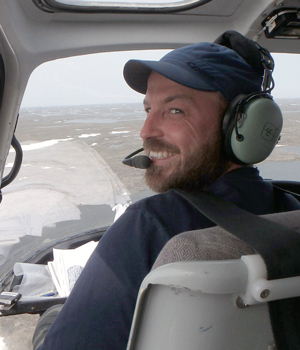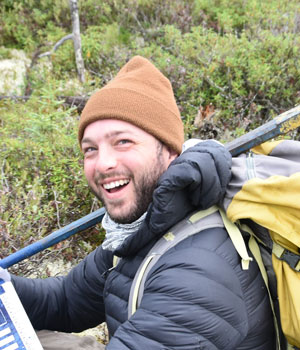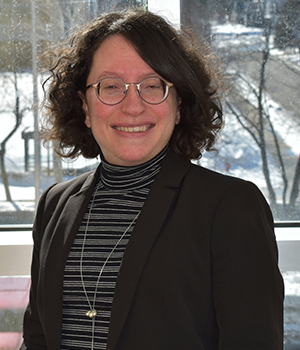Back to program
Quebec’s Quaternary Deposits: A Rich Sedimentary Layer at the Heart of Major Issues
Wednesday, November 20, 2024
Room 403
Most of Quebec’s territory is covered by different types of deposits whose genesis is inherent to the evolution and activity of the Laurentide Ice Sheet.
This layer, whose thickness and sedimentological characteristics are highly variable, bears witness to the major episodes that punctuated the last glacial cycle and to the subsequent deglaciation.
On one hand a hindrance to mineral exploration, on the other a valuable recharge area for surface aquifers, this layer offers multiple uses and challenges for land and resource management.
The plurality of research activities dealing with Quaternary deposits reflects the importance and richness of these records for the Quebec territory. This conference session will provide an opportunity to explore various research themes relating to these sedimentary records, including mineral prospecting, natural hazards, and paleoclimatic and hydrogeological studies.
1:30 p.m.
Welcome Address
1:35 p.m.
Application of the pXRF Mobile Laboratory to Quaternary Geological Surveys: A Drift Prospecting Tool
Conference details
Complex glacial dynamics in the northern regions of Quebec have left a thick layer of sediment that partially or completely conceals the basement, thus limiting mineral exploration. Surveys and geochemical analyses of the secondary environment provide a rapid, global overview of the mineral potential of these regions. However, laboratory geochemical analyses are very costly, and delays in obtaining results can compromise the responsiveness of field teams and the monitoring of anomalous areas.
The Ministère des Ressources naturelles et des Forêts (MRNF) conducts annual Quaternary surveys combining sampling and mapping of surface deposits. In order to increase its analytical capabilities and maximize the scope of the surveys, the procedures described in the guide ‘Utilisation du pXRF pour l'analyse des dépôts de surface et introduction au laboratoire mobile du Quaternaire du MERN’ (‘Use of pXRF to analyze surface deposits and introduction to MERN's mobile Quaternary laboratory’; Hébert et al., 2021; MB 2021-04) were used to obtain in situ geochemical results during work in isolated areas. This presentation follows the deployment of the pXRF laboratory during the field work carried out by the Direction de l'acquisition des connaissances géoscientifiques (DACG) in the north of the Ungava Peninsula (Nunavik) in 2022 and 2023.
The purpose of setting up the mobile pXRF laboratory was to validate the deployment and usefulness of this new approach and its integration into the field work. It was also intended to test the established analytical protocol and validate the calibration parameters of the pXRF analyser. During the summers of 2022 and 2023, the mobile laboratory analyzed 265 and 118 samples respectively.
Sediment geochemical data obtained by pXRF were subjected to comparative statistical analysis with conventional analytical methods to determine elemental precision and accuracy for grain-size fractions < 125 μm and < 63 μm. The results were used to target different areas with interesting mineral potential, facilitating a more detailed secondary sampling. Spatial interpolation methods for the targeted zones were also analyzed by comparing raw interpolations with interpolations based on compositional data. Finally, a laboratory configuration and a protocol adapted to the constraints of a camp in isolated areas were proposed in order to optimize the deployment of the laboratory and the daily manipulations.
1:55 p.m.
The Contribution of Quaternary Geology to the Development of the Mineral Potential of the Churchill Subprovince (Nunavik)
Conference details
The Ungava Bay Lowlands and the surrounding regions of Nunavik occupy a privileged geographical position in relation to the centres of glacial dispersion formed by the Labrador-Quebec Dome. The rich and varied morphological and sedimentary records from this region are major sources of information on the evolution, migration and melting of this sector of the Laurentide Ice Sheet during the Wisconsinan and Holocene periods.
However, the various deposits and glacial forms recognized in this sector represent a major obstacle to the search for economic minerals and deposits. Mineral exploration remains a challenge in the areas affected by Quaternary glaciations, where access to the basement rock is fragmented.
In this context, the Direction de l'Acquisition des connaissances géoscientifiques du Québec (DACG) carried out a glacial (till) and glaciofluvial (esker) deposit sampling program combined with mapping of surface deposits at scale 1:250,000 in the southeastern part of the Churchill Province from 2012 to 2015. The aim of the project was to assess the region's mineral potential using drift prospecting, and to provide a geoscientific knowledge base of the region's Quaternary geology to guide exploration work.
Over 1,000 till samples and 200 esker samples were collected and analyzed using various techniques (fine fraction geochemistry, analysis of heavy mineral concentrates, trace element geochemistry using LA-ICP-MS, etc.). These analyses, together with subsequent statistical treatments, were used to identify zones with high mineral potential and to characterize some of the mineralizations responsible for these dispersions in the secondary environment. A total of 39 prospective zones, ranging from local to regional in scope, were defined, covering a wide variety of mineralization contexts and illustrating the diversity of mineral potential in the southeastern Churchill Province. The most notable of these zones show strong potential for magmatic REE mineralization, as well as for IOCG-type geological settings.
2:15 p.m.
Mapping of Surface Deposits in the Gaspé Peninsula: The Contribution of LiDAR Imagery to Advancing Knowledge of the Quaternary and Water Resources
Conference details
The Quaternary period in Quebec was marked by glacial and interglacial cycles during which ice sheets formed and fluctuated according to climate variations. These phases of glacial advance and retreat left behind a complex surficial sedimentary sequence. The sedimentological, geochemical and genetic characteristics of these deposits play a decisive role in the dynamics of groundwater recharge areas, the main source of drinking water for many communities in Quebec. Accurate mapping of these deposits is therefore crucial to ensuring sustainable management of this essential resource. Traditionally, the mapping of surface deposits has relied on the interpretation of aerial photographs, a complex and imprecise process due to the thick vegetation cover concealing surface sediments and the subtleties of the terrain. This method also produces low-resolution mapping, making it difficult for the specialists who depend on this data to carry out their work. It is now possible to overcome this obstacle thanks to the availability of data from airborne LiDAR surveys. The topographic data thus acquired enables precise and detailed mapping and characterization of the nature, distribution, extent and geometry of surface deposits. This technology therefore plays a major role in advancing our knowledge of water resources and landscapes strongly shaped by Quaternary glaciation.
In this respect, this project fits in with the new PACES Gaspésie project, providing a major update of the mapping of surface deposits in the peninsula. The project will result in the production of 24 map sheets at scale 1:50,000 covering the entire Gaspé Peninsula. This information will substantially enhance our knowledge of the Quaternary and water resources in the area, by improving our understanding of glacial history and dynamics, as well as the sedimentary products of deglaciation, and the post-glacial evolution of the landscape. In addition to advancing scientific knowledge, this mapping will have practical applications in the management of natural hazards, such as landslides, infrastructure planning, mining exploration and environmental impact assessment, providing an essential tool for local and regional decision-makers.
2:50 p.m.
Glaciolacustrine and Glaciomarine Episodes in Central Ungava (Nunavik): Implications for the Archeology and Quaternary History of Northern Quebec
Conference details
The recession of the Laurentide ice sheet in northern Quebec and Labrador (Canada) led to the formation of several large glacier lakes. The drainage of these lakes could have influenced North Atlantic Ocean circulation and climate during deglaciation. However, impact assessment of these repeated meltwater discharges on the ocean-climate system is limited by the lack of data on the configuration (area and volume) and chronology of these glacial lakes, as well as on the position of the ice margin that controlled their evolution. In addition, the incursion of postglacial marine waters into the region complicates the interpretation of a number of shoreline sequences that recorded these events, particularly in the south-central region of Ungava. Understanding the geomorphological processes that have shaped the area is also relevant to archaeological research, which has revealed the presence of several pre-contact sites that attest to the occupation of the area (campsites, migration routes, etc.) by indigenous groups.
This master's project focuses on the geomorphological and sedimentary records of the area comprising the Caniapiscau and Koksoak river-valleys, south of Kuujjuaq (Nunavik). The mapping of eskers, moraines and meltwater channels, based on satellite images and digital elevation models, has made it possible to reconstruct the regional deglaciation pattern. A study of glaciolacustrine and glaciomarine paleoshorelines, deltas and terraces helped establish the respective configuration of these bodies of water. The cartographic observations were validated by fieldwork, which also included high-precision differential GPS elevation measurements (± 1 m) of key features along a 170 km N-S transect. The water bodies were reconstructed using a Geographic Information System (GIS) to illustrate the position of palaeosurfaces and the approximate regional physiography at the time of their existence (~7 ka BP).
The results of this work indicate that the shorelines recognized in the Caniapiscau and Koksoak river-valleys and in the Lake Cambrian basin are predominantly glaciomarine in origin. The combination of the glacial retreat pattern determined from cartographic data and modelling indicates that a glacial lake developed in the south of Lake Cambrian and in the adjacent basins to the east, with a surface area of around 2,500 km2 and a volume of 105 km3. In addition, cosmogenic nuclide dating of boulders found on these shores at different elevations has yielded 14 ages 10Be, indicating that the drainage of the Cambrian glacial lake and the concomitant marine incursion occurred around 7200 ±200 years BP. The progressive land emergence caused by the post-glacial rebound culminated in the withdrawal of marine waters from the study area around 4400 ±200 years BP.
Collectively, these results reinforce the pattern and chronology of glacial retreat in the region during the last deglaciation and provide a chronological framework for human migration and settlement in north-central Ungava by Naskapi ancestors. In addition to clarifying the magnitude of meltwater discharges in this region at the beginning of the Holocene, the new cosmogenic dates also make it possible to refine paleogeographic reconstructions of southern Ungava Bay.
3:10 p.m.
Studies and Understanding of Landslides in Quebec Sensitive Clays
Conference details
The geological history of Quebec has led to the formation of marine clay deposits that are sensitive to remoulding. According to data from the Ministère des Transports et de la Mobilité durable (MTMD), an annual average of 213 cases of landslides involving soil and rock were reported between 2010 and 2023 by the Sécurité publique (MSP) and forwarded for opinion to the MTMD, 197 of which occurred in soil. Between 2017 and 2023, this annual average increased to 276 cases, 256 of which occurred in soils.
In this context, the MSP, the MTMD and the Laboratoire d'études sur les risques naturels of the Université Laval are participating in a research program on natural geohazards. This program, funded under the Government of Québec's Loss Prevention Framework and 2013-2020 Climate Change Action Plan, has the following objectives: 1) to improve knowledge of geohazards and their consequences in relation to climate change, in order to better plan land use in areas vulnerable to landslides; 2) to establish the best options for risk prevention and mitigation; and 3) to train highly qualified personnel to manage issues related to landslides.
This presentation will introduce the main axes of the research program and provide an overview of the types of landslides that affect these sensitive clay deposits, including retrogressive landslides. These are divided into two main types: clay flows and spreads. Clay flows occur when remoulded sensitive clay flows as a result of a succession of circular breaks, leaving an almost empty scar. Spreads occur when a rupture surface propagates almost horizontally through an intact clay mass, dislocating the overlying soil into more or less intact blocks that form horsts and grabens in the landslide scar. The consequences of these two types of landslide can be disastrous for people and infrastructure, given their large surface area and the speed with which they occur. Case studies will be used to describe the specific morphology and failure mechanisms associated with these landslides and their consequences. The main tools available to better understand and analyze these landslides will be described. Finally, the priority issues and research avenues concerning these landslides will also be discussed.
3:30 p.m.
The Clay Enclave of Northwestern (NW) Quebec and Northeastern (NE) Ontario: Updating Our Knowledge of Surface Geology in the Context of Adaptation to Climate Change
Conference details
Adapting to climate change and mitigating its risks can bring both challenges and opportunities. The clay enclave (CE) of NW Quebec and NE Ontario, a vast region of fertile soils with high agricultural and forestry potential limited by a low number of frost-free days, could experience profound changes associated with global warming. Ouranos predicts that the average annual temperature in the region could increase by 2.9°C by 2050. The anticipated warming could therefore favour market garden production and extend the growing season, allowing large areas to be used for growing corn and soy, which are currently restricted to the areas along large bodies of water. However, Ouranos' predictions also show that the warmer summers of 2050 will be accompanied by precipitation levels comparable to today's, pointing to serious water deficits.
Current assessments of the area of CE used by agricultural and forestry specialists vary widely from one author to another. It is therefore important to first establish the distribution of CE surface deposits and determine their physical and geochemical properties. The clay plain of NW Quebec and NE Ontario is punctuated by rock outcrops, glacial, fluvioglacial and glaciolacustrine drifts, glacier surge, and post-glacial deposits in a proportion that can be quantified using digital maps of surface deposits produced by the Geological Survey of Canada (GSC), the Ontario Geological Survey (OGS) and the Ministère des Ressources naturelles et des Forêts (MNRF). In addition, with global warming leading to water deficits, access to groundwater is becoming a priority, hence the need to accurately identify recharge areas and confined aquifers. Close cooperation with UQAT's Groundwater Research Group (GRES) and other organizations in Quebec and Ontario is therefore necessary to achieve these objectives. The final document will provide exhaustive geoscience data that will contribute to a better understanding of the environment, which is essential for informed decision-making in matters of sustainable development, adaptation to climate change and resource management in a region with major mining and forestry infrastructures. This research project is part of the 2024-2029 Environmental Geoscience Program run by the GSC-Quebec and aims to create a single digital atlas of environmental reference data for the CE.
3:50 p.m.
End of the session






